
Darts is a great indoor game, one you can enjoy with friends, but also with your family at home. If you have children and they’re used to seeing you play darts, there will certainly come a time when they’ll want to do the same. But when’s the right time to start teaching your kid how to play darts? Here are some recommendations we’ve gathered by talking to several passionate players who have children.
What type of darts should your kid start playing with?
No matter what kind of darts you want your child to start playing with, in the end, they’ll most likely insist on playing with the same ones you do. In this case, whether you play with steel tip darts or plastic tip darts, you should get ready to train your child to use the same tools as you. There is no right or wrong type of dart, you just have to make sure your kid is mature enough to understand how to use theirs without harming themselves or others.
The ideal age for plastic tip darts
This type of darts you use to play on an electronic dartboard have soft tips that are made of plastic. The great advantage this brings along is the fact that you can’t pierce your skin with these as the tips are not sharp like those of steel tip darts. However, due to their shape, weight, and the fact that professional darts have heavy barrels made of tungsten or other metals, these darts can be dangerous too.
Throwing them around at objects or, even worse, at other persons could cause damages and wounds. For this reason, although safer than steel tips, darts with soft plastic tips still require sufficient skill and maturity to be used correctly. If your kid has simply fallen in love with your electronic board and is eager to play by your side, you should wait until they are a least 7-8 years old to start teaching them how to play.
The ideal age for steel tip darts
If you’re an avid darts player, you probably have a traditional bristle dartboard at home, which means you’re playing with steel tip darts. While these classical darts feel great in your hand and challenge your skills with every throw, they do pose some risks for little ones.
Their sharp tips can be dangerous if they hit any part of your body, so you should think twice before you allow your kid to start using your set of darts. Set some clear rules from the beginning and highlight the possible consequences a dart wound could have. Especially if you have two or more children who want to play together, it’s essential to supervise them in the beginning and make sure they don’t harm themselves or each other with the darts.
How soon you allow your kid to start playing with steel tip darts depends on how mature and well behaved they are. While some parents feel comfortable and safe letting kids as little as 8 throw this type of darts, many agree that the ideal age to start using steel tip darts is somewhere between 9 and 10.
If your child is still little but eager to start learning darts, it’s always a good idea to play with them in the beginning and avoid letting them use steel tip darts while you’re not at home, especially if playing with siblings.
As they start perfecting their technique, you can allow them to play alone or with others without being supervised, especially if you trust them and you’re confident that they won’t use the darts for any other purposes than hitting the target.
Use darts gear for kids
While this might not be the most exciting way to use your darts skills, you can make a sacrifice every now and then and play with your child using darts gear for kids. There are different dartboards and dart sets that are targeted to the specific age and skills of children as little as 3.
These darts tools might look and feel more like toys than actual darts gear, but they are safe and easy to use. Getting a dartboard and a darts set for children can be the perfect start point for your kid as these products are less heavy and don’t have sharp tips. Most options on the market are crafted for children aged 6 and above, but you can also find minimalistic models for kids aged 3+.
Kids love to imitate their parents’ behavior and if you are an avid darts player, your kid is quite likely to grow up practicing this sport too. Playing darts together is a great way to bond with your kid, have fun, and release those mood-boosting endorphins. When deciding what age is the right age to start playing darts with your kid, remember the suggestions above.

There are two things you need to play a game of darts. You need a set of darts and a dartboard, everything else is optional and it’s also important to have a well-lit space.
There are different styles of dartboard and darts available but the most popular are bristle dartboards and steel tip darts. .
One of the common mistakes beginners make when playing darts, is having their bristle dartboard set up in the wrong way. If you fail to set up your dartboard correctly, every time you play on a dartboard elsewhere, it will feel differently and that’s not a good way to practice.
Before attaching the dartboard to the wall, make sure you are using a space where the floor is flat. If the floor slopes away from the dartboard, this means the distance at which you are throwing is wrong. Furthermore, you should never set up a dartboard where there are windows or valuable items.
This first thing you must be aware of when setting up a dartboard correctly, are the measurements. There are three main measurements to look out for.
Firstly, the dartboard must be mounted at the correct distance from the floor. The official measurement for a bristle dartboard is 5 ft 8 inches high (173 cm) from the floor to the bulls eye (the center of the board).
Therefore, the mounting bracket should be positioned so that the dartboard is located at this distance in relationship to the ground.
When attaching the dartboard to the wall, make sure it is flush against the wall and not leaning forward in any way. If the dartboard is leaning forward, this will make the measurements inaccurate and you will find the dartboard wobbles when you throw darts. It must be flat and secure, so it doesn’t move or fall forward.
The second measurement you need to check is from the front of the dartboard to the oche, which is where you will be throwing your darts. The simple way to do this is to purchase a dart mat, that has the measurement already printed on it. All you need to do is lay the dart mat on the floor according to the instructions.
The other good thing about a dart mat is that it protects the floor and this is important when using steel tip darts. Bounce outs are inevitable and if you don’t want your steel tip darts to cause holes in the floor, you should buy a dart mat.
However, if you don’t want to buy one simply measure 7 ft 9¼ inches (237 cm) from the front of the dartboard, along the floor and mark this distance with a line.
Finally, to check you did everything correctly, use a tape measure to verify the measurement from the bulls eye down to the oche. The distance should be 9 ft 7 and 3/8 inches (193 cm) and if it does, you are now ready to play darts.
Keep in mind, these measurements are for a bristle dartboard and steel tip darts, for any other form of darts they may be different.
If your dartboard isn’t correctly mounted, now you know what to do. You will see a huge difference in your darts game once everything is set up correctly!

Selecting the best darts is crucial when you start playing darts for the first time. Each player has a unique set of darts and if you search for them online, you will find many sets of darts designed and endorsed by pro players. However, spending a large sum of money on your first set of darts could be a mistake.
As a beginner, selecting a set of darts because your favorite player uses them or simply because they look good, is not the best option.
Instead, you should analyze the darts in terms of weight and grip. The shafts and flights also need to be considered carefully and we will come back to this later.
As a beginner player, you are advised to start by using heavier darts rather than something light like 18 grams. The extra weight will help you keep the dart’s consistency as it flies through the air and into the dartboard. A lightweight dart will be more difficult to control and therefore you should aim for somewhere around 25 grams as an ideal weight for beginner darts.
As you develop your skills, you can decide if you would like to upgrade the weight or downgrade it depending on how your style develops over time.
both 24 gram and 26 gram steel tip darts and these are a great option for beginners.

Many people are wondering how to throw darts in the right way. Fortunately, several resources are out there that could help them solve that problem. However, learning how to throw darts does not necessarily depends on merely listening to the possible suggestions and instructions. The best way to learn how to throw darts is none other than playing the game, but having an excellent guide from the beginning is a very good thing.
Now, here are the dos and don’ts of a dart throw.
On Joints and Levers
The shoulder: In learning how to throw darts, one should note first that the shoulder is the only point in the whole process that does not change its position. Therefore, in order to get a good hit, you must not move your body when throwing. Obviously, that’s the first DON’T. Now where does the throwing action come from? The answer is your “arm”.
The elbow: In aiming the dart, the elbow should stay in position especially when moving the dart forward. This is also helpful on some point in the acceleration phase starts to go up. Well, this is no doubt a very interesting thing. As you may have known, it is the elbow that would force you to release the dart earlier. Also, in learning how to throw darts, one should carefully note that the elbow must be raised in the later phase of throwing, but the hand still follows the way of the dart after releasing it. According to some experts, this will make the release easier for the fact that we don’t have to find a completely accurate release point any more.
The wrist: Usually, in most of the discussions regarding ways on how to throw darts, the wrist action is often the subject matter. Well, for some people, there is not much of it, but for most pro players a consideration on the wrist action is very vital in learning how to throw darts. The primary reason behind this is basically the claim that the wrist action helps in the acceleration. If you do wrist snap, the tip of the dart will accelerate faster, enabling you to move the other parts of the lever system slower. So, in learning how to throw darts, you must put less force in your throw to improve accuracy. However, there is one risk in wrist snap, that is, it is one more thing that must be controlled and so one more source for errors. Control it if you can!
Object of Desire
The dart: If you want to learn how to throw darts, you must keep in mind that the main object of desire in this game is the dart. Since it is often suggested that the dart should move in a parabolic curve, then make it happen. Note that in the geometric language of how to throw darts, the dart must always be in line with the throwing parable’s tangent in the angle of intersection of your hand and the parable. In learning how to throw darts, you should note that the dart points up in the aiming position which must be increased in the backward movement and decreases steadily in the acceleration part. Just note that a dart that points down in any of the throwing phases is very bad. That’s another DON’T!
Please leave me a message below and tell me if you tried to follow these suggestions and if they improved your dart game in any way.

The dart grip is the most personal element of playing darts. Whether you are watching the professionals playing on television or playing yourself, with friends at the pub, you will notice every player has a different type of grip and it can change the
way darts will land in the dartboard.The first point to make, is there is no right or wrong way to grip a dart.
However, there are a few basic rules to follow, when gripping a dart for the first time.
Find the dart’s center of gravity by placing it in the palm of the hand you will be using to throw it with. Then, move the dart to the fingertips of the same hand, keeping it in the same position and take hold of the dart, with your thumb one side of
the barrel and your fingers on the other.Make sure your grip is not too loose or too tight. Imagine holding something light and fragile in your hand, if you hold it too tight, it will break but if you hold too lightly, it will fall. Darts is a precision sport and accuracy can only be found with
a controlling but relaxed grip.The number of fingers you use when holding the dart, will influence the amount of control on the dart and the ease in which it leaves your hand. The more fingers you have on the dart, the more control you can place on it but the more difficult it will
be to release. A good starting point, is to place three fingers on the dart and practice like that, before making any changes. The length and shape of the barrel on the dart you are using, will also impact on how many fingers you hold it with.Any fingers which are not being used to hold the dart, should remain apart and not closed into a fist. Closing the fingers up, will produce extra tension in your hand and result in a poor throw, so keep them open and relaxed. When using steel tip darts,
the tip of the dart should be facing up. Always check this, especially if your dart is not hitting the dartboard with the tip first.With your grip in place, it now time to throw the dart.
When throwing the dart, do not move your body, this should remain stationary at all times, once in place at the oche. Ensure your eyes, the dart and the part of the dartboard you are aiming for, are in line when taking aim. When moving the dart back,
it’s best to avoid contacting your face if possible. Some players like to do this and it’s great to move the dart back as far as possible but any additional contact may disrupt the throwing mechanism.When accelerating forward, do so at a natural pace. There is no need to force it, just concentrate on doing it naturally, all the way to the follow through. When releasing the dart, the tip must be pointing forwards, not down and as you have the correct
grip in place, the actual release of the dart will come naturally. Again, do not force it. If you have the correct elements in place, as described here, the release will come naturally.To finish the release, do not forget to follow through with your arm, at which point your hand should be pointing at the chosen target on the dartboard. Keep it there for a brief moment, before allowing it to fall.
These are the basic principles of how to hold a dart and how to throw it.

Are you passionate about darts? Then, you surely want to learn as much as possible about this fascinating game that’s being played all over the world. Here are some fun darts facts that will help you improve your knowledge and impress other players during your next match.
- It is believed that darts came into being during the reign ofKing Henry VIII of England whose soldiers started playing the game.
- There are more than 3,900 waysto hit the 9 dart finish in a 501 game.
- In darts, ‘Bed n breakfast’ meansa score of 26. The name was inspired by the traditional price of bed and breakfast in England that used to be 26 pence back in the old days.
- Many people believe that the dartboard is made of horsehair or pig bristle, but that’s just a myth. Today, dartboards are made from sisal fibersobtained from a plant.
- The game of darts was legalized in an ‘unorthodox’ way by a pub owner in Leeds, in 1908. After being arrested for letting people play darts in his pub, the owner asked a skilled player to compete with a court clerk to demonstrate that darts is actually a game of skill and not an illegal game of chance, which he managed to do.
- In 2012, a darter was kicked out of an English tournament because, due to his appearance, viewers kept chanting Jesus, which prevented other players from focusing on the game. A year later, he was banned from entering the competition for the same reason.
- In the past, people used to make darts from cut down arrows or crossbow bolts. The flights were originally made of Turkey feathers.
- There was a time, during the past century when, in the UK, darts was bannedfrom the place that prompted it as a popular social game – the pub because players would bet on the outcome.
- The darts oche took its name from Old Flemish where the word ‘oche’ means notch or nick.
- Since 2005, when Sports England officialized darts, this game has turned into a sport, although many still choose to consider it a mere game.
- There is no age limitto playing darts, anyone who is able to throw a dart can join the game.
- Darts enhances your ability to focus, as it requires a lot of concentration.
- Darts boosts your mental capabilities due to the fact that it involves a lot of calculation (subtracting, doubling, and tripling numbers). Therefore, darts can improve your mental mathematics.
- Darts is one of the cheapest sports you can engage in, with a set of darts & a dartboard costing a little more than $100.
- Darts is one of the few sports in which spectators who attend the game are also allowed to participate in the competition.

There are many tips and strategies you can apply if you want to get better at darts. However, there is no gain without pain, as they say, so don’t expect the progress to be sudden. Many professional darts players train for several hours a day, for a few years, before they manage to conquer a title. Just like any other sport, darts requires time, patience, and of course, pleasure. If you’re really into this sport and you want to become better at it, here are some areas you should focus on.
Mind your position
In the beginning, you might not put great emphasis on your posture because you will be focusing only on throwing darts and making sure they reach the target. Moreover, if you’re playing darts with friends in a pub, probably no one minds this aspect a lot. However, professional darts players advise us to position ourselves correctly if we want to play this game the right way.
A correct position implies stepping behind the throw line and in a straight line with the dartboard. If you extend an arm forward, you should see it aligned with the dartboard. This position is essential because it allows you to launch your darts directly toward the board and aim easier.
Always Follow Through
The way you grip your darts is important as your grip is directly linked to your darts’ trajectory and chances to score. Whether you grip your dart with 2, 3, or 4 fingers, you should make sure that your chosen grip allows you to throw with confidence while feeling comfortable.
However, there is another aspect you should also mind when launching darts. Your arm should always follow through. Your throw doesn’t stop once the dart is released. By moving your arm forward even after you release the dart (aka ‘follow through’), you add more consistency to your throws.
Track your progress
To know what skills you need to improve in order to get better at darts, you should track your progress. This will happen naturally because you will realize how your aim is improving. However, there is something else you should be focusing on: the part of the board you hit.
In short, there are two essential areas you will be focusing on, if you practice common 01 games like 501: the high numbers and outs. You can start by focusing on each one of them. For example, aim to hit the same high numbers several times in row, to improve your target. Once you feel comfortable with those, start doing the same with outs, and always keep track of your progress. Count the number of times you were able to hit a certain number.
Be mentally prepared for darts
Darts is an entertaining activity, however, if you really want to make headway, you will understand that this requires both physical and mental preparation, just like any other sport. Darts involves a lot of concentration. In fact, many pros state that it is 90% mental and 10% physical. If you take a look at many darts champions, you will realize that, indeed, you don’t need to have outstanding physical qualities for this sport because the key to their success is dexterity and focus.
To train your mind for this game, if you feel that you’re lacking the necessary concentration, you can apply different strategies: meditation, breathing techniques, a regular sleep schedule, music, all these can help you boost your concentration.
Finally, don’ forget that you need quality darts gear if you want to be able to play this game properly and master it one day. Don’t go for the cheapest set of darts that bounce out or loose their shafts while you practice. This will only make things hard and disappointing. There are numerous quality darts products out there and they don’t cost an arm and a leg. At IgnatGames, you can find professional darts and dartboards, along with a series of reliable accessories and regular discounts. Check out our catalog for more info!

In darts, just like in life, self-control is very important. This is the key factor that often makes the difference between losing or winning at darts. After you’ve reached a certain skill level and you’re physically capable of making any throw, self-control is what you should be focusing on to make sure you win almost every match. Read on and see why self-control is so important in darts and how you could improve it.
What is self-control in darts?
Self-control is the opposite of impulsivity and, when playing sports, we often act based on impulse and emotions, in the rush of the moment. Just think about those famous soccer players that end up fighting in the middle of the game …. Now you know what I’m saying 😊. Although darts players are generally fun-loving people who love to socialize over a glass of beer as much as they love throwing those small projectiles, they too can get angry, especially when they lose.
Maybe you fall into this category as well, so learning how to define and identify your self-control is the first step towards managing it. People with poor self-control are usually impatient and they tend to act based on their emotions and feelings, not on reason. This is why they may sometimes fail to achieve their goals or complete certain tasks. They become overwhelmed by anger, stress or other feelings that prevent them from focusing. This often happens to professional sportspeople too, especially during important matches when the pressure is great and takes its toll.
In darts, self-control is extremely important because it is directly linked to a player’s capacity to focus. If you’re angry, feel stressed, or disappointed, you’re emotions can plot against you. By focusing on them instead of your target, throw and posture, you’ve got high chances of failing. As you already know, in this game, the slightest movement can make a great difference. Simply gripping your dart a bit differently or releasing it to early can make you lose points.
Self-control is essential in darts because this game is based rather on concentration than on physical strength. Many say that it is 90% concentration and 10% physical effort. Therefore, to be able to truly focus on your game, you need to let go of negative emotions while you’re at it. At the same time, you also need to focus on your body posture and feel balanced and comfortable while throwing.
Improving your self-control
There are numerous reasons why you might get angry during a game of darts and the outcome is more than often going to be negative. Bad emotions lead to hasty decisions that often trigger failure. To avoid getting at the end of the game and seeing your opponent win, you need to find the right mental and physical balance and reproduce it over and over again, with each throw. Pro players refer to this state of balance as the ‘optimal release time and posture’.
The first step to get there is to recognize your negative emotions, what caused them, and then take active steps in managing them. Many players lose their self-control right in the middle of the match because they see their opponent performing better than they do or they feel like this person is trying to sabotage them. The best thing, in this case, is to focus on the ultimate goal: winning.
If you let your anger or jealousy dominate you, you are actually helping your opponent win. Think rationally, you’re there to play. Whether you win or lose, the most important thing to focus on is delivering your best performance. Do whatever you can to secure your victory by focusing strictly on the game, not what’s happening outside of it.
Here are some common techniques professional darters, and generally, professional sportspeople often rely on to improve their self-control and focus:
- Meditation
- Breathing exercises that alleviate anxiety
- Listening to music
- Enjoying a good night’s sleep before the competition day
- Practicing mindfulness by focusing on the present moment

Darts is a lot of things. It is a professional sport played in official tournaments, a fun game you can play with friends and also a challenging activity that can improve multiple personal skills. From enhanced concentration to better people skills and more self-control, there are a lot of positive changes you can achieve in your personal life by playing darts. Find out more about the personal skills this game can help you strengthen.
Improves your strategic thinking
Darts is anything but easy. To succeed in this game, you need more than good hand-eye coordination and the ability to hit the target. Darts requires a lot of strategic thinking, which is a much-appreciated skill that’s also necessary in many jobs and day to day activities.
In darts, your mind works continuously, as you have to carefully plan each throw and think about the number of points you’d gather if your dart reached the desired spot. This is both a physical and a mental game. Learning how to grip and throw the dart correctly doesn’t automatically make you a winner. You’ve got to put a lot of mental effort into this game as well, which, in the long term, helps you sharpen your logical thinking.
Promotes concentration
To many advanced players, darts is like a form of meditation. This is possible because this game requires a lot of concentration. When you’re standing in front of the dartboard and you’re getting ready for your next throw, all your thoughts are pointed in that direction only.
All the while, the rest of your daily concerns are put on hold, which is the same thing you achieve by meditating. Darts can help you boost your concentration and your capacity to truly focus on one essential task, which is a skill your boss will definitely appreciate you for.
Strengthens your social skills
It goes without saying that darts is a social activity. Whether you play it professionally and you take part in official competitions, or you play with friends or strangers in a bar, this sport connects you with others.
One of the main reasons why darts is so popular is, in fact, its social nature. People love it because although darts is a competitive game, it is also one that allows you to socialize. You share the same dartboard with others and you play standing next to each other, which leaves little room for harsh feelings or silence. If you’re a friendly person or one that would like to make more friends, we highly recommend you play darts.
Makes you more confident
Since darts implies connecting to others, it can also help you achieve more confidence. If you’re not the type of person who loves to draw attention but would like to gain a little bit more courage to do so, then darts can help you out.
The moment you grab that dart and approach the dartboard, you automatically get noticed, which might feel awkward in the beginning, but will definitely help you get out of your comfort zone and boost your confidence in time. Moreover, if you become good at it, you’ve got all the more reasons to feel proud and grow that self-esteem of yours because winning at darts is by no means easy.
Helps you gain balance
Unlike other sports that put more emphasis on physical skills, darts is more about focus and strategic thinking. These two abilities train your mind in so many different ways, helping you achieve more self-control.
Concentrating on your dart throws requires mental effort. Your mind and your body have to work hand in hand to help you aim, which makes you more self-aware of your position and your physical abilities allowing you to gain more control.
Darts can greatly improve your balance and coordination. At the same time, because it implies a high level of commitment, it also turns you into a more disciplined and calm person, improving your mind and body control.
All in all, there are many personal skills you can improve by playing darts and equally many physical skills. This game is fun, healthy, and can literally turn you into a better person.

As with any sport, some players have a natural talent and others need to work hard to play well. Darts is no different but however good you are naturally, you will only improve your darts skills if you practice.
Here are 5 great ways to improve your darts skills:
- Practice hitting the doubles. On a good quality bristle dartboard, the double segments should be nice and clear and you should have no trouble when attempting to land steel tip dartsinto this section of the board. However, it is a very small, crucial area of the board and whatever scores you record to get the double if you cannot hit the double you will not win. Pick a double and see
how many times you can hit it within 10 minutes and then move on to the next one around the board. - Checking out is one of the most difficult aspects of darts for beginners. Trying to count down what you have left to leave yourself a double can be tricky, especially when under pressure. To help improve your checkout skills, start with the number
99 and try and finish it. When doing so, think about which double you want to leave and how you will get there. Once you have done it, move down to 89 and so on. - Playing with accuracy is key to winning a darts match. While every board you play darts on in a bar or club is a standard bristle dartboard, there are other styles of bristle dartboard you can buy to practice on at home. For example, the Ignat Games
Assassin Blade ProBristle Dartboard features doubles which are approximately 4 mm wide and if you become good at hitting the doubles on this board, you will enjoy great success on a standard size bristle dartboard. - If the equipment you are using isn’t suitable, your scores on the dartboard will suffer. Go to a specialist darts store and try using the different steel tip darts they have available. Every good darts store will allow you to practice using different
weights and styles of steel tip darts and help you to select the ones which are best for your style of throw. You will be surprised how having a set of steel tip darts which have been selected personally for you, will help to improve your game. - If you are playing in a league or cup match for a team, how you prepare yourself for the match is very important. Having a good warm-up will improve the way you play from the first dart of the match. Professional darts players will warm up for many
hours before matches and while you do not need to do that, having a warm-up routine before a match will help you play better darts. If you are short on time before a match, use your practice darts to throw at double 20, the bullseye and then double
3. By aiming for these numbers, you will have a feel for throwing at three different heights on the board, which is extremely helpful.
Keep these 5 ways to improve your darts skills in mind and as you implement each of them, you will see your game developed.
- Practice hitting the doubles. On a good quality bristle dartboard, the double segments should be nice and clear and you should have no trouble when attempting to land steel tip dartsinto this section of the board. However, it is a very small, crucial area of the board and whatever scores you record to get the double if you cannot hit the double you will not win. Pick a double and see
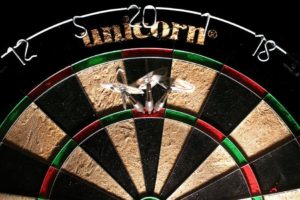
You may just be curious, or perhaps you have begun to take up the game yourself. But is darts a sport?
Yes. Darts is a sport. England, United States, Ireland, Scotland, Netherlands, Germany, and Belgium have recognized darts as an official sport. Although it is possible to play as a hobby (as with most sports), darts requires players to be well-aimed and to compete at a high level.
Regardless of your personal opinions of darts as a sport, this is a question that deserves some looking at. Below all about the considerations of darts as a sport and its official recognition.
Understand we are talking mostly about steel tip darts here. While we do consider soft tip darts sport as well, it is still in its early stages without world organized play or televised games.

By Definition:
Dictionary.com defines a sport as “an athletic activity requiring skill or physical prowess”.
To add to this, the Oxford Dictionary defines a sport as: “an activity involving physical exertion and skill in which an individual or a team competes against another or others for entertainment”.
although the exertion may be lesser than many sports, it does require a physical prowess to be able to hit the target.
To add to that, the skill and prowess that is needed are done in competition against another individual.
By Skill Level:
one of the main reasons people question the authenticity of darts as a sport is due to the simplicity.
Any average human can pick up a dart and toss it at the dartboard. At this level, it requires minimal physical exertion and you may even hit the board fairly frequently.
Anyone who has tried to play beyond this probably understands where I’m going; hitting a bull’s eye, or even your intended target, is much more difficult than it appears.
Standing just under 8 feet away from the dartboard, and tossing a dart, which to an untrained hand does not feel well balanced, it is quite an accomplishment to get the darts to stick to the board at first.
As time goes on you may have a better aim or even be able to get it to stick frequently. This constitutes growth and a skill level that must be developed through practice.
By Competition:
If you are really invested in darts, you may even be aware of the world championships surrounding the sport. Players at this level train and travel from all around to compete.
Competitions run for Europe, the U.S. and other individual countries. If you are a skilled player, you always have the ability to go up in darts, making it a much more competitive sport than at your local club.
By Organizations:
There are two mainstream professional darts organizations – the British Darts Organization (BDO) and the Professional Darts Corporation (PDC). For amateur organizations, The World Darts Federation (WDF) is the main one.
Having this type of system, and organization to which players belong is a hallmark of any professional sport. Darts definitely has the resources of a “real sport”.
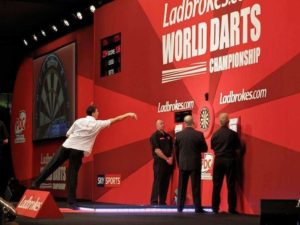
While each organization has its own rule book, the basic outlines are the same.
The official rules for the PDC have been issued by the Darts Regulation Authority (DRA). This is a not-for-profit company in the United Kingdom, whose sole purpose is to provide, update, and regulate the rules of darts. The BDO has its own rule book which is split into 2 sections, Playing Rules and Tournament rules.
Where Can I Watch Darts On TV?
As with most sports, you can watch current and past games on TV and online. If you have seen darts on television – it has likely you have been watching
BBC Sports and Sky Sports.
You can also watch plenty of old dart matches online for free on YouTube.
How Many Types of Darts Games Are There?
When speaking strictly professionally, the main darts game we are speaking of is straight in 501 darts. You will very rarely see anything else being played on TV. However, there are a ton of different types of ways to play darts, some of the most common being:
-Cricket
–Baseball
–Around the Clock
–Shanghai
Most people stick to the basics but the list of dart games you can play on a standard dartboard is huge.

Since darts is a sport, darts should be on the Olympic stage. The community and competition are already fierce, and there are professional organizations to back them up.
The sport of darts is accepted in many of the largest countries of the world and is at least played as a game in most of the others. There is, however, one main issue with including darts in the Olympics.
The largest obstacle for Olympic status is the split between the PDC and the WDF. Since the World Darts Federation is the governing body, being in the Olympics would put it under their control.
Darts has gained popularity quickly since it became a sport. First hitting television in the 1930s to a limited audience, by the ’70s most countries were recognizing official rules and organizations were forming around it.
The community stretches to most countries in the world is safe to say that the community and organizations surrounding the darts community are well-structured and here to stay. You will have no problem finding active and serious competition in this sport.
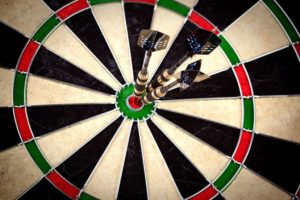
This depends on the governing body and who is recognizing the sport. The most prominent place to recognize darts as an official sport is probably Sport England, in 2005.
In a game of 501 the bulls eye does count as a double. Meaning if you have a score of 50 remaining, you can finish the game landing your dart in the bull’s eye.
While the whole target (green and red) is referred to as the “Bulls eye”, it is common for players to use slang to differentiate the outer ring and the center circle. Single bulls’- eye, double bull’s-eye, is one, green bull, red bull is another.
The Alan Evens shot is when you land all three of your darts in the red bull’s-eye section. It is a term made popular by dart commentator Sid Waddell.
The Reference is in regard to Welsh dart player David “Alan” Evans who was well known for this shot. It is reported on a Scottish tour that he finished on 150 (hitting 3 bulls’ eyes) 8 times during play
Well, if you’ve been around the sport for a while, you are probably thinking, did this guy forget about the 180?
It is important for newcomers of the game to know that the bull’s-eye is not the spot worth the highest point value on the board.
Each number on the dartboard has a doubles and triples segment. These sections are much smaller and thus significantly harder to hit. However, if you manage to hit one, you can multiply the point’s value of that number by either 2 or 3 and get much higher scores per turn.
So if you hit a triple 20 with each dart, your points that turn will be 180, a full 30 points more than if you hit 3 bulls eyes.
In fact, in standard games of x01, there are many numbers on the board that have targets that are worth more than the 50 point inner circle; triple 19 is worth 57 points, triple 18 is worth 54 and triple 17 is worth 51 points.
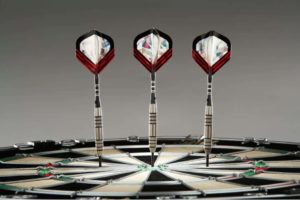
Everyone can play darts.
However, just because anyone can be a good dart player does not mean everyone can be an excellent player, and darts has an incredibly high skill ceiling. Want proof? Look no further than the coveted Perfect Game of darts!
So, what is a perfect game of darts?
A perfect game of darts or a perfect “leg” happens when a player is able to check out from 501 using the fewest possible number of darts, which is nine. Hence the name, nine-dart finish.
A nine-dart finish is extremely difficult to achieve. In fact, most players can spend their entire lives chasing one and never score it.
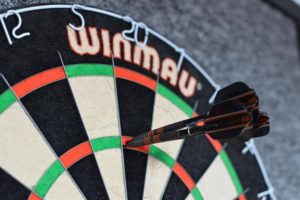
If you really want to attempt the herculean task of scoring a perfect leg, you’re going to have to arm yourself with patience.
It’s a long-distance trip! You’ve been warned.
There are actually several paths to score a nine-dart finish.
However, it starts, like most other games of darts, with a 501.
Since the highest score one can achieve with a single dart is 60, and each shot consists of three darts, 180 is the maximum score per round. Building on that, the minimum number of throws to win is nine.
Therefore, if a player scores a 60 on each of their first 6 throws, they would have to score a 141 on the last shot.
This is where things open up as several possible combinations net the player a 141.
For example, a player may score a treble 20, a treble 19, and a double 12.
A player may also score a treble 17, a treble 18, and double 18.
If the player is feeling confident and believes luck is on their side, they may attempt to score a 180 on the first shot, 171 on the second shot, and 3 bulls-eye on the final shot for a total of 501.
The possibilities are too numerous (There are close to 4,000 different combinations of 9 darts that score 501) to list them all, but you get the gist.
Here Are Some Notable Facts about 9 Dart Finishes
A perfect game is notoriously difficult, but darts has had some notably legendary players. So, yes, of course, there have been perfect finishes throughout the years.
Phil Taylor, who is an absolute beast of a darts player, has scored 11 perfect legs during televised matches throughout his career.
Raymond van Barneveld, Michael van Gerwen, and Adrian Lewis have all scored 5 during televised matches throughout their careers.
2012 saw an astounding 7 perfect legs, and 2014 saw a total of 6.
2016’s PDC World Darts Championships provided fans with the spectacle of 9 perfect legs.
2017’s Premier League Darts had 8 Nine-darters throughout the tournament.
If we study the stats, we can see that the elite players are, in fact, getting better at achieving perfect legs. Nevertheless, they are still incredibly rare. I’m talking about something that happens, on average, about once every 5,000 legs!
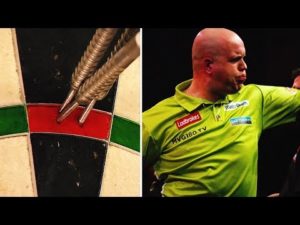
No. There has not been a perfect set in darts. At least not one that has been televised or can be proven.
You see in professional dart you play multiple legs (games) per set. Usually, there are 5 legs in a set so best 3 out of 5 wins. Since perfect legs are so rare, a perfect set would be quite an accomplishment.
The closest we have seen so far is 2 9 dart finishes in a set. The first by Phil Taylor in the 2010 Premier League final, and the second by Michael van Gerwen in a 2017 UK Open qualifier match
Don’t Be Upset If You Never Get A 9 Dart Checkout
Darts is a straightforward game and anyone can play. Without exaggeration, I can confidently say that anyone can play darts and do it well.
This is not true of most sports since many of them have a pretty strict set of physical requirements that can prevent a lot of people from ever becoming good at them.
Throwing a perfect game is the most difficult achievement in darts.

One of the most common questions is which dartboard to buy? After all, anyone looking to take their skill to the next level has to get a dartboard to practice at home. You simply cannot become a better darts player by playing with your mates at the CLUB every other week or so.
The answer is always, The Blade 5, of course
“Which one? There’s more than one type of Blade 5 dartboard!”
And it’s true! Currently, there are several models of the Blade 5 you can purchase however, in my experience, the choice comes down to:
What’s the Difference between Blade 5 and Blade 5 Dual Core?
The Blade 5 and the Blade 5 Dual Core are a very similar dartboard. The difference is that the Dual Core has an extra layer of sisal fibers, giving it added durability and longevity over the standard Blade 5.
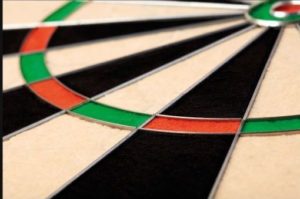
To the uninitiated eye, both of these dartboards may look the same, but the difference in their construction warrants a conversation. So let’s see what each one has to offer.
What Is A Dual-Core Dartboard?
A dual-core dartboard is a dartboard that has a second layer of sisal fiber in its core. This second core helps grip the darts, adds durability, and prolongs the life of the dartboard.
Let’s Take A Look at The Blade 5
What might surprise some people is that the Blade 5 is actually their highest selling dartboard of all time!
So what sets this board apart from the heaps of other dart boards on the market?
It has designed to increase the playable scoring area in both the double and treble scoring areas, and without making the board more cumbersome or altering its total dimensions.
And how did they do this? Thinner spider wiring, that’s make the wire thinner (a reduction of 14% less wiring to be exact). This means that you end up with a higher scoring potential .

Another area of improvement over previous generations is the number of bounce-outs you will avoid when playing with the new and improved Blade 5.Ttheir also vastly improve the player experience with another change in the wiring redaction the degree of the wire angles, which means that darts that would previously bounce outwards, now get guided in towards the dart board.
Another practical and overlooked improvement is the inclusion of a triple wheel Rota-Lock system that significantly reduces the time that the player has to dedicate to the board’s installation and rotation. With the triple wheel lock-and-level system, you can easily attach this board to pretty much any surface.
So, Is the Blade 5 Dual Core Worth It?
Yes. If you are buying a dartboard, it is worth spending the extra money to get the dual core version of the Blade 5. The second core will make sure your dartboard lasts longer, thus saving you money in the long run.
Both bristle boards are a fantastic addition to any setup. The Blade 5 is certainly no slouch and is already a vast improvement over previous generations. However, the Blade 5 Dual Core offers an undeniable advantage and in my opinion, is worth the slightly higher price.

Of all the English speaking countries in the world, England most definitely takes the cake when it comes to weird phrases and strange terminology.
Just look at the way score is kept during a tennis match, or try to follow a game of cricket. And Darts, perhaps the most quintessential British pastime, is no slouch when it comes to strange and funny-sounding terminology.
For example, bed & breakfast, fish & chips, Annie’s attic. Each phrase has a story and a distinct origin.
But there is one word, essential to the game, whose true meaning and origins have eluded most throughout the years.
That’s right, it’s the Oche!
But what is an oche in darts?
The oche is the name given to the throw line in darts. It is the line at which a player must stand behind when throwing their darts at the dartboard.
How Do You Pronounce Oche?
You pronounce Oche like hockey without the H, aah-Key. You may hear it called slightly different, but that is usually due to local accents or the person just not knowing the correct pronunciation.
The origins of how the word oche became the name of the darts tow line are unclear. There are however several theories as to how the name oche came about.
Patrick Chaplain, one of the eminent authorities on darts history, posits a few informed theories which may or may not be right.
He believes that the term is an evolution of the Finnish word “Hocken,” which means to spit. Apparently, back in the early days of the sport, players would spit to determine the distance to the dartboard from which they would throw.
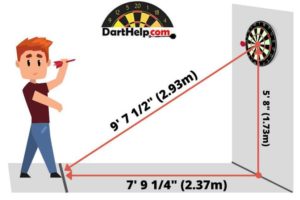
The oche is marked at 7 ft 9 1⁄4 inches away from the dartboard for steel tip darts when measured along the floor. For soft tip darts, the distance is 8 feet.
For those who measure in metric, that’s 2.37 meters for steel tip and 2.44 meters for soft tip
Official tournament play is very clear on where to draw the line, pardon the pun.
It’s also important to note that an oche may not be taller than 40mm high, 20mm deep and 500mm wide.
Sometimes a diagonal distance is measured from the bull’s-eye to the oche as a reference.
Rules of The Oche
During a shot, the dart player’s feet cannot step on any section of the raised oche. A valid position for a dart throw is one in which a player’s feet are positioned behind the raised edge of the oche. Any throw taken outside of this context will not count towards the total tally.
Sometimes a player is allowed to throw their darts from a point on either side of the oche line. However, the same rules apply. Therefore, the player’s toes may not step beyond an imaginary line parallel to the raised Oche.

Yes. You may lean over the line while throwing your darts. As long as your feet remain behind the oche, any other part of your body may extend past the line. Leaning too far may cause issues with balance and reduce accuracy and consistency.
Dart Mats
Dart Mats are my favorite solution for several reasons. Like the laser oche, they can be removed when not in use. They have the throw lines marked at the correct length so you do not need to remeasure even of you take it up and put it down, its perfect every time. Lastly, they save wear and tear on your floor. If you play for more than a couple hours each week, a mat is the way to go.
Why Not Just Call It the Toe Line?
Some people will refer to the oche as the toe line or throw line. However, the term oche has been an integral component of the game’s jargon for decades now.
The bottom line is that no one knows where the term originated. Call it the Oche, call it the toe line, call it the throw line. Call it whatever you please. Just don’t ever step on it!
